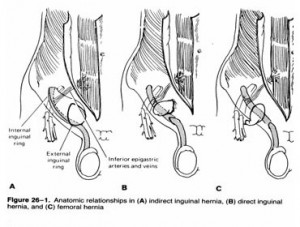Hernia Repair
A hernia occurs when a small sac containing tissue protrudes through an opening in the muscles of the abdominal wall. The technical name for the operation that repairs a hernia is called a herniorrhaphy. This will explain:
- Why you may need a hernia repaired
- The ways in which a hernia can be corrected surgically
- What to expect before and after the operation
Remember, as routine as a hernia repair is, no two people undergoing a herniorrhaphy are alike. The reasons for and the outcome of any operation depend on your overall health, your age, the severity and size of your hernia, and the strength of your abdominal tissues.
herniorrhaphy are alike. The reasons for and the outcome of any operation depend on your overall health, your age, the severity and size of your hernia, and the strength of your abdominal tissues.
This booklet is not intended to take the place of your doctor’s professional opinion. Rather, it can help you to begin to understand the basics of these surgical procedures. If you have questions, you should discuss them openly with your doctor.
About Hernias

A hernia develops when the outer layers of the abdominal wall weaken, bulge or actually rip. The hole in this outer layer allows the lining of the cavity to protrude and to form a sac. Any part of the abdominal wall can develop a hernia. however, the most common site is the groin. A hernia in the groin area is called an inguinal hernia. Inguinal hernias account for 80% of all hernias. In an inguinal hernia, the sac protrudes into the groin toward – and sometimes into – the scrotum. Although most common in men, groin hernias can also occur in women.
Another type of hernia develops through the navel, and is called an umbilical hernia. A hernia that pushes through past a surgical incision or operation site is called an incisional hernia. A hiatal hernia forms when the upper portion of the stomach slides into the chest cavity through the normal opening created by the oesophagus, or food pipe.
Who Gets Hernias?
Most inguinal hernias in adults result from strain on the abdominal muscles, which have been weakened by age or by congenital factors. The types of activity associated with the appearance of an inguinal hernia include:
- Lifting heavy objects
- Sudden twists, pulls or muscle strains
- Marked gains in weight, causing an increase in pressure on the abdominal wall
- Chronic constipation, which places a strain on the abdomen while on the toilet
- Repeated attacks of coughing
A hernia is called reducible if the protruding sac of tissue can be pushed back into place inside the abdomen. If the hernia cannot be pushed back, it is called irreducible, incarcerated or imprisoned.
The symptoms of inguinal hernias vary. Sometimes the onset is gradual, with no symptoms other than the development of a bulge. Other times, the hernia will occur suddenly with a feeling that something has given way. This feeling can be accompanied by pain or discomfort.
Signs and symptoms of inguinal hernias can include:
- visible bulges in the scrotum, groin or abdominal wall
- a feeling of weakness or pressure in the groin
- a burning feeling at the bulge
- a gurgling feeling
In some cases, an irreducible hernia gets so pinched that the blood supply is cut off and the tissue swells. Rapidly worsening pain or a tender lump is a signal that the hernia has strangulated. When strangulation occurs, the tissue can die quickly and become infected. Within hours this condition can lead to a life threatening medical emergency that requires immediate medical attention.
Contact
Dr Karihaloo practices from the second floor of the Lake Macquarie Specialist Medical Centre.
Level 2, Suite 1
Lake Macquarie Specialist Medical Centre
6-8 Sydney St, Gateshead NSW 2290
If you have any enquiries or to make an appointment phone (02) 4947 8177 or email admin@surgerycentral.com.au
